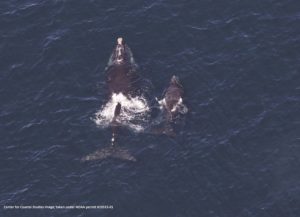PROVINCETOWN — Dragon, a female right whale who gave birth to a calf as recently as 2016, was spotted two weeks ago entangled in rope 50 miles south of Nantucket. She was malnourished and underweight, likely because the entanglement was preventing her from feeding.
This might be the last we see of Dragon. Because she has lost so much blubber, she will likely sink, rather than float, when she dies. That’s a problem for scientists, because whale cadavers can help them determine the cause of death, update mortality statistics, and identify the source of the entangling gear.
Center for Coastal Studies scientist Stormy Mayo said that Dragon’s plight is part of a larger trend: female right whales are dying at a higher rate than males. With fewer females to produce babies, the chances of a future for the species are reduced.
“The numbers of calves over the past five years has been very low, and the mortalities have been very high,” Mayo said. Although the number of calves this year — 10 were spotted off Florida last month — is “wonderfully higher than the past four years, it’s not enough.”
Richard Pace, a wildlife biologist with the National Oceanic and Atmospheric Administration, estimates that 133 right whales died between 2010 and 2017, or about 19 animals each year. But only 39 carcasses were found, as the remaining 94 sank before being spotted. During the same time period, 115 calves, or about 16 per year, were born, resulting in a higher mortality than birth rate.
Because only 50 percent of calves reach adulthood, Pace estimates that at least 30 births would be needed this year to compensate for deaths.
Changing Patterns
Scientists understand right whale deaths better than they do reproduction. “There are lots of gaps,” said Mayo. “The animals are roaming bodies of water, areas out in the ocean that we just don’t know about.”
What is known is that female whales typically migrate to warmer waters in Florida and Georgia to give birth. Their calves need three weeks to grow enough blubber to survive the colder northern waters. Afterwards, the pair begins the journey to Cape Cod and as far north as Nova Scotia, where plentiful food can be found in spring and summer.

It is this reproductive migration that puts female right whales at greater risk than males. As they travel from Canada to Florida and back, the chances they’ll come into the path of fishing boats and gear are higher.
One of the calves born this year has already suffered a major injury from being hit by a boat. Mayo is concerned that the calf cannot form a seal to nurse milk from its mother, and its recovery, like Dragon’s, is unlikely.
Cape Cod Bay is a seasonal home for right whales. Mayo estimates that at least 278 animals, or 65 percent of the North Atlantic population, were in the bay last spring, and dozens have already returned this season. They’re easily spotted from Herring Cove and Race Point.
But these patterns are changing.
Reproduction has dropped in recent years. Healthy female right whales should give birth every three years, but the current average is every six or seven years, Pace said. Scientists don’t know why that is so, but say it is likely due to nutritional and other stresses. The result, though, is clear: fewer births.
Bigger mammals, like right whales or elephants, tend to reproduce less frequently than smaller mammals because of their longer life spans, Pace said. Right whales typically lived well over 60 years, but these days their life expectancy is closer to 40 years with increased mortality from boat strikes and entanglements in fishing gear. With female right whales dying at a rate of 5 percent per year, Pace said, they are not living long enough to replace themselves.
Complicating scientists’ abilities to understand whale behavior, the geographic distribution of right whales is changing with the climate crisis.
For example, right whales typically eat copepods, tiny crustaceans swimming in the ocean. In the past, these could be found near Nova Scotia and the Gulf of Maine, carried in by ocean currents. Those currents have slowed because of warming, however, and right whales are moving elsewhere to find food. Recently, whales have been spotted south of Nantucket and near George’s Bank instead of farther north.



